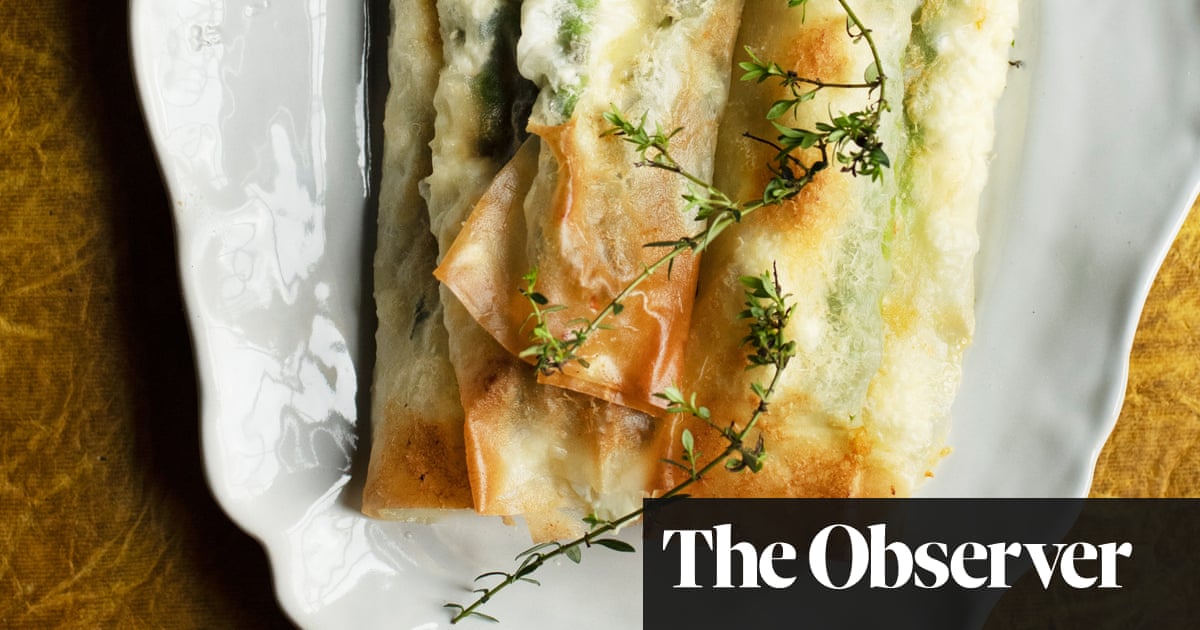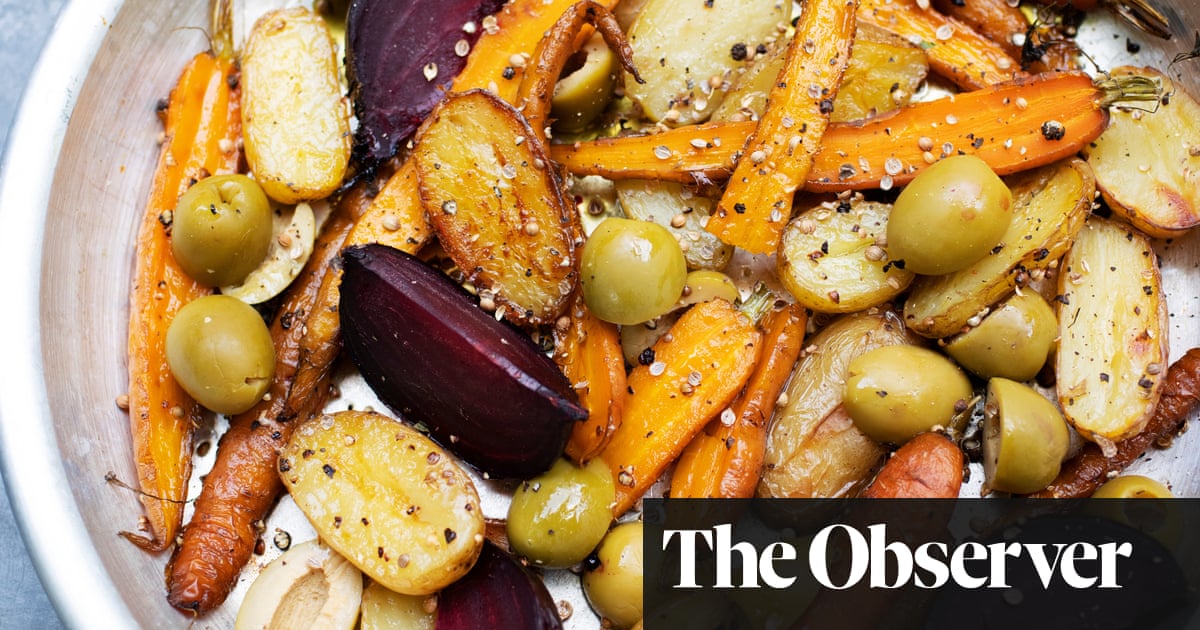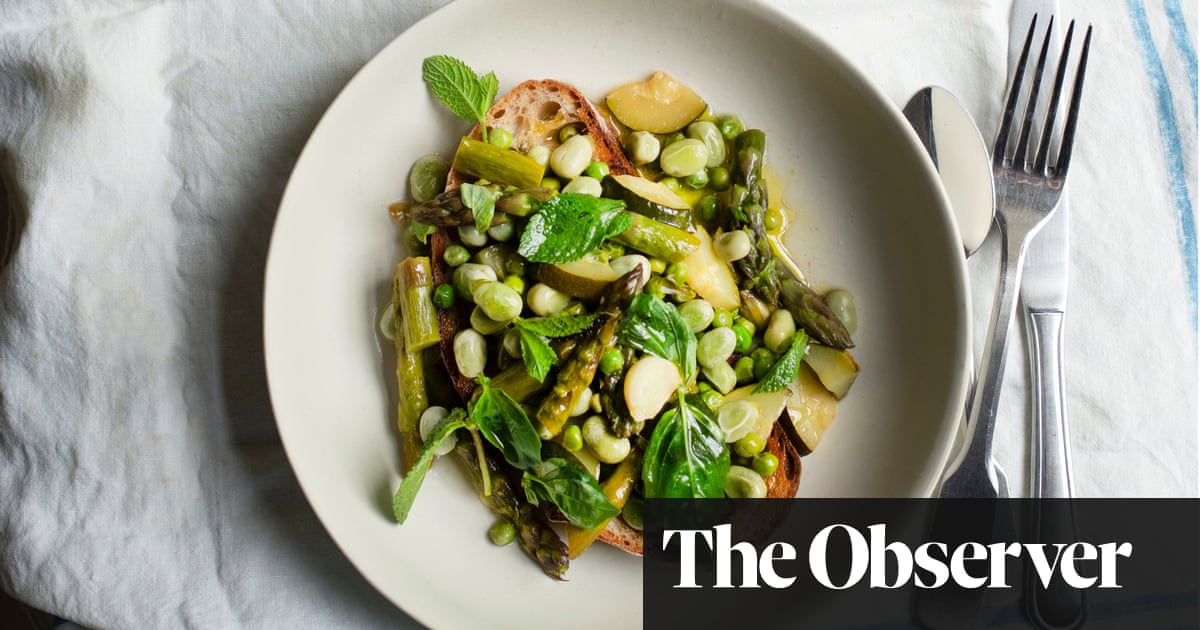
Afew steps from the kitchen door is a low wooden table creaking with pots of herbs. Knocked together from a packing crate and an old door, now weathered and green with moss, it is home to almost all of my kitchen herbs including thyme and tarragon, several varieties of mints and a lemon verbena. There are two or three clumps of chives, green and golden marjoram (beautiful, but tasting pretty much identical), others of basil and rosemary, and several rose- and lemon-scented pelargoniums.
The herb table came about simply because I ran out of space on the kitchen steps. What started as the odd homegrown thyme bush soon became quite a collection, though I will admit to losing as many as I have safely nurtured, probably more.
I grow herbs in pots because the soil in the garden is too heavy and rich for most varieties to thrive. Most herbs prefer a thin, well-drained soil – where mine is as rich and claggy as sachertorte. Pots, mostly terracotta – a few made from coir – have turned out to be a better home for them, where I can mix their peat-free compost with plenty of grit for drainage, so their roots don’t sit in the wet, which most herbs hate.
As the summer lingers, I let them flower – those of the chives and rosemary are particularly enchanting – and if I grew coriander I would look forward to that, too, for its lacy white umbrellas of blossom. (Coriander and parsley are used in profusion in the kitchen here, I pick them up from the shops in cheap, fat bunches instead.)
Overwintering herbs in my garden is a bit hit and miss. The thymes tend to come back every year, though in my experience rarely stronger than the initial year, and the oreganos and rosemary are pretty reliable too. However, I treat most of my kitchen herbs as annuals and, not having a greenhouse, replace them each spring. Dill and fennel do well in large pots, though grown apart in case they cross pollinate. (Good luck with overwintering basil plants.)
And I’ll tell you a little secret about homegrown herbs; even a single pot of thyme on the windowsill can bring a certain pleasure. You don’t even have to cook with it, just crush the leaves in your hands, cup them to your face and breath in deeply.
Baked tomatoes, basil bean cream
A bells and whistles version of tomatoes on toast here, but with good reason. As you slice into the baked tomatoes, their sweet-sour juices spill deliciously over the soft mound of herb-speckled bean puree – a taste of deep summer.
Makes 4 toasts
tomatoes 12 small-medium (500g)
thyme sprigs 6
olive oil 3 tbsp
sourdough or ciabatta 4 slices
For the bean puree
haricot beans 1 x 400g tin
olive oil 5 tbsp
basil 20g
garlic 1 small clove
Set the oven at 210C fan/gas mark 8.
Put the tomatoes snugly in a roasting tin, tuck in the thyme sprigs, then pour over the olive oil. Season with salt and black pepper, then bake for 20 minutes or until the tomatoes are soft and their skins are just starting to burst.
Drain the beans and bring them to the boil in a pan of fresh water. (I often add a few sprigs of thyme and a couple of bay leaves, but it is not essential.) Lower the heat to a simmer and leave for 10 minutes. Drain the beans reserving a tablespoon of the cooking water. Put the beans into the bowl of a food processor, add a little salt and black pepper, the 5 tablespoons of olive oil and the basil leaves. Peel and add the clove of garlic, then process for a few seconds (only) to a thick, green cream.
Toast the bread on both sides. Spread the basil cream over it, then divide the tomatoes between the toasts, spooning over any thyme-scented juices from the pan.
Summer pilaf with preserved lemon and salted ricotta
There is a certain ease to this pilaf, the grains of rice freckled with herbs and green summer vegetables. It is as good served at room temperature as it is when eaten straight from the pan. With seasonings of salty ricotta and sour preserved lemons, the rice has something of a spring it its step. I bring this to the table as it is, but it makes a fine side dish for cold salmon or slices of smoked mackerel too.
Serves 2-3
broad beans a couple of handfuls, about 200g (shelled weight)
asparagus 250g
For the pilaf
white basmati rice 120g
butter 35g
bay leaves 3
green cardamom pods 6
black peppercorns 6
cinnamon 1 stick
cloves 2 or 3
cumin seeds a pinch
thyme a couple of sprigs
To finish
mint leaves 8 large
parsley, coriander 30g (total weight)
spring onions 4
preserved lemons 45g
salted ricotta 50g
Cook the beans in deep, lightly salted, boiling water for 3 or 4 minutes. Drain and pop the largest of the beans from their skins. Any very small beans can be left as they are. Trim the asparagus, removing any tough ends, then cut the spears into short lengths. Boil or steam for 5 or 6 minutes until just tender, then drain.
Wash the rice three times in a bowl of warm water. This will prevent it sticking together. Melt the butter in a saucepan over a moderate heat, add the bay leaves, the cardamom pods lightly crushed to reveal their seeds, the peppercorns, cinnamon stick, cloves, cumin seeds and thyme. Stir the spices and herbs around in the butter for a minute or two, then, as soon as they are warm and fragrant, drain the rice and add it to the pan. Stir the rice to coat it with the butter then pour in enough water to cover the grains by 2cm.
Season with ½ a teaspoon of salt, turn down the heat so the water simmers, then cover tightly with a lid. After 7 minutes fold in the drained asparagus and the broad beans. Replace the lid and cook for a further 5 minutes. Remove from the heat, leave the lid in place and set aside for 3 minutes.
To finish, put the mint leaves on top of one another, roll tightly, then shred finely. Remove the parsley and coriander leaves from their stems and finely chop. Finely slice the spring onions, discarding the dark shoots. Halve the lemons, discard the flesh inside and finely dice the skins. Stir the herbs, diced lemons and spring onions into the rice and transfer to a serving dish. Crumble the salted ricotta finely and scatter over the rice.
Green beans with lemon and tarragon
I like to serve a small and elegant deep-summer salad alongside a plate of roast spring carrots or sautéed courgettes. Such a dish is also substantial enough to be a main course when served with a rice pilaf. There is a beautiful contrast of textures here, with long, slightly crisp climbing beans and plump broad beans and tiny garden peas. I cook the peas only briefly, so they are almost raw, but let the green beans cook longer, until they just start to bend, when their flavour seems at its best. The creamy quality of the dressing is lifted with tarragon vinegar, though a plain, white wine vinegar will do if that is what you have. The dish is served slightly warm rather than hot.
Serves 2 with rice (4 as a side dish)
lemongrass 2 large stalks
creme fraiche 200g
green beans 150g
young peas in the pod 100g (weight in pod)
small broad beans 350g (weight in pod)
tarragon leaves 2 tbsp, chopped
tarragon or white wine vinegar 1 tbsp
Cut the lemongrass stalks in half, then bash them with a heavy weight to splinter the stalks. Put them in a saucepan, add the creme fraiche and bring to the boil. Immediately remove from heat, cover with a lid and leave to infuse.
Bring a medium-sized pan of water to the boil. Top and tail the green beans and cook them in the boiling water, lightly salted, for 5 minutes or until tender but still lightly crisp. Remove from the water and set aside. Add the peas in their pods to the water and cook for 3-4 minutes, then drain and add to the beans.
Bring the water back to the boil, pod the broad beans then cook in the boiling water for 4-5 minutes depending on their size. Drain and set aside and, if you wish, remove from their skins.
Remove the lemongrass from the creme fraiche and stir in the chopped tarragon, a little salt and pepper, and the tarragon or white wine vinegar. Toss all the beans and peas in the creme fraiche dressing and serve.
Rosemary kefir rolls with beetroot, dill and smoked salmon
A generously stuffed roll is my first choice for a picnic. A fat, fluffy bun will stay in better condition than a sandwich and is easier to transport. If I am making the rolls myself, I might fleck the dough with herbs – thyme and rosemary are especially good – and a little salty cheese such as feta or salted ricotta.
Makes 6 large rolls
plain flour 500g
fast-acting yeast 1½ tsp
sea salt ½ tsp
kefir 200ml
olive oil 3 tbsp
warm water 100ml
feta cheese 200g
rosemary 3 bushy sprigs
thyme 5 bushy sprigs
For the filling
cider vinegar 2 tbsp
honey 2 tsp
grain mustard 1 tsp
dill 2 tbsp, chopped
beetroot 300g
smoked salmon 250g
To finish
olive oil a little
thyme and rosemary a few sprigs
Put the flour, yeast and salt in a large, warm mixing bowl. Put the kefir in a jug, add the olive oil and the warm water and stir well. Combine the kefir mixture and flour with a wooden spoon or your hands and mix until you have a soft and slightly sticky dough.
Crumble the feta into a small bowl. Remove the leaves from the rosemary and thyme, and finely chop them to give you 1½ tablespoons and add to the crumbled cheese.
If you are making the dough by hand, tip on to a floured board and knead the cheese and herbs into it. If you prefer the easy way, use a food mixer fitted with a dough hook to knead the cheese and herbs into the dough. Continue kneading for a couple of minutes, adding a little more flour if necessary to stop it sticking, then put the dough back in its bowl, cover with a clean, warm cloth and put it in a warm place. Leave the dough in peace until it has risen to almost twice its original size.
Line a deep-sided baking tin with a piece of baking parchment.
Cut the dough into 6 equal pieces then shape each one into a round bun. Place the buns in the baking tin, three down each side, then return to the warm place, cover with the cloth and leave for about 30 minutes, until nicely risen and touching one another.
Set the oven at 210C fan/gas mark 8. Toss the herbs in the olive oil and scatter them over the rolls then bake for about 20 minutes, until lightly golden brown.
To make the filling, in a medium-sized bowl, use a fork to mix together the cider vinegar, honey, mustard and dill.
Peel and coarsely grate the beetroot into the bowl, toss with the dressing, then set aside for 20 minutes.
To serve, split the rolls in half and fill with the beetroot and dill salad, fold slices of smoked salmon and place on the beetroot, then close the sandwiches and serve.
Cantaloupe with basil and mint
Throughout the summer, there are melons, in various shades and stages of ripeness, in the kitchen. Once ripe, they are moved to the fridge to thoroughly chill. Some are sliced and eaten for breakfast, others share a plate with thin folds of culatello or Iberico ham. Occasionally, those melons end up in salads, their juices seasoned with basil or mint and used in the dressing.
When the evenings are really hot, I sometimes put scoops of ripe melon – honeydew, cantaloupe or charentais – into a syrup of elderflower, mint and basil. You can make your own syrup with elderflower cordial and sparkling water or use a bottle of ready-made elderflower drink. Lightly crushing the herb leaves as you tuck them among the melon scoops releases their fragrance into the syrup.
Serves 4
mint 6 bushy sprigs
basil leaves 12, large
elderflower drink 750ml, chilled
orange 1
cantaloupe melon 1 ripe 1.5kg
Wash the mint sprigs then put them in a deep bowl, lightly crushing the leaves in your hand as you go, to release the fragrance. Do the same with the basil. Pour over the elderflower drink. Cut the orange into thick slices and tuck among the herbs.
Halve the melon. Using a spoon, scoop out and discard the seeds and core. Cut the flesh into large pieces and add to the marinade. Set aside for two hours in the fridge until thoroughly chilled. Serve the melon in individual glasses, then strain the elderflower syrup over the fruit.












